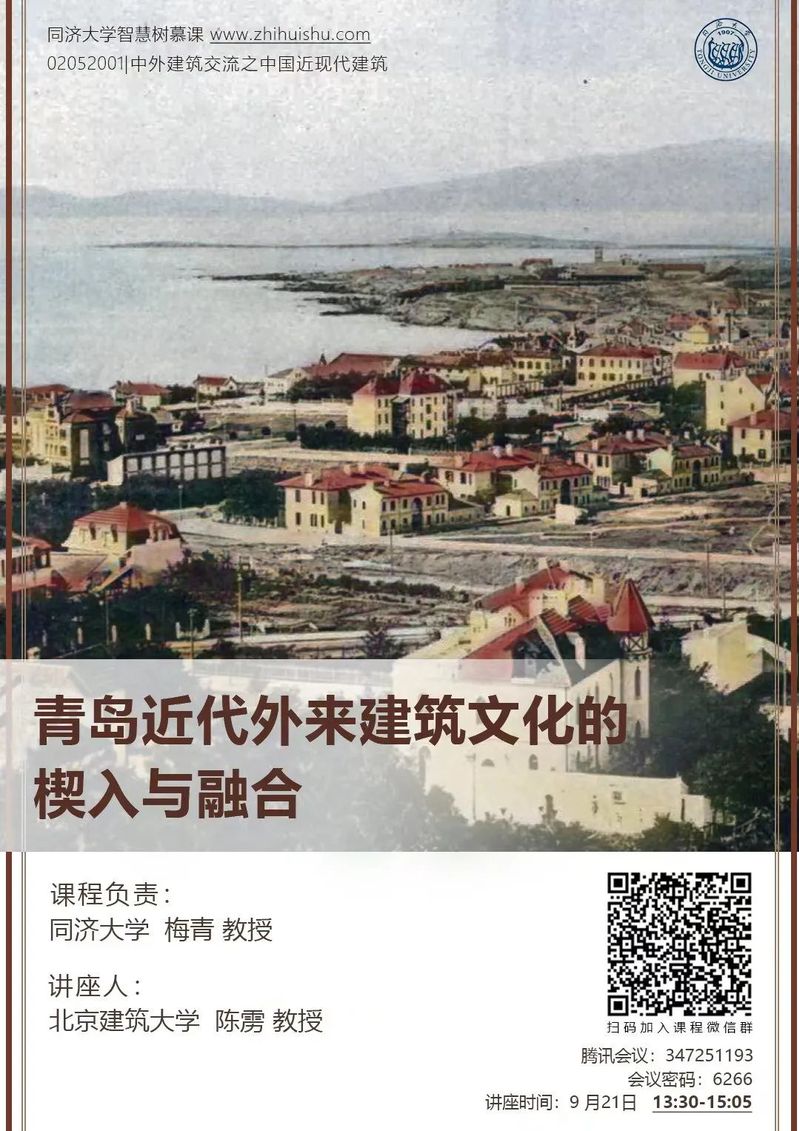新闻中心



中外建筑交流之中国近现代建筑专题讲座
Sino-Foreign Architectural Exchange-Modern Architecture in China Seminar
同济大学智慧树慕课 www.zhihuishu.com
02052001 中外建筑交流之中国近现代建筑

An Embedded Integration of Foreign Architectural Culture in Modern Qingdao
青岛近代外来建筑文化的楔入与融合
讲座时间
Time: September 21, 2022 (Wednesday), 13:30–15:05
时间:2022年9月21日(星期三)13:30-15:05
参与方式
Tencent Meeting ID: 347251193, Password: 6266
腾讯会议号: 347251193, 密码: 6266
主讲人
CHEN Li 陈雳
北京建筑大学建筑与城市规划学院教授。天津大学建筑历史与理论博士,同济大学城市规划博士后,两次获得德国学术交流中心(DAAD)资助,德国亚琛工业大学、班贝格大学访问学者,国家留学基金委资助南澳大学访问学者。
多年从事中国近代城市建筑和建筑遗产保护的研究,出版学术专著3部,发表学术论文100余篇。2020年出版专著《城建溯踪——青岛近代城市遗产发展探究》,全面介绍了受外来文化影响的近代城市青岛的建筑形成和演变发展。
Mr. Li CHEN, Professor of School of Architecture and Urban Planning, Beijing University of Architecture. He was granted doctoral degree in architectural history and theory from Tianjin University. He once worked as a postdoctoral fellow in urban planning from Tongji University. He was funded twice by the German Academic Exchange Service (DAAD) as a visiting scholar at RWTH Aachen University and Bamberg University in Germany, as well as a visiting scholar at the University of South Australia funded by the China Scholarship Council.
His research fields are mainly focused on Chinese modern urban architecture and architectural heritage conservation. And his representative publication in 2020 is Traces the Changes in Architecture - An Exploration of Qingdao's Modern Urban Heritage Development, which comprehensively studies the architectural formation and evolution of Qingdao, a modern city influenced by foreign cultures. Professor Chen has already published three academic monographs and over 100 academic papers in related field.
课程负责人
MEI Qing 梅青
梅青,女,博士后,现任同济大学建筑与城规学院教授,博士生导师;厦门大学建筑与土木工程学院兼职教授。兼任联合国教科文组织亚太地区世界遗产培训与研究中心(上海)(WHITRAP)顾问,中国古迹遗址保护协会(ICOMOS CHINA)会员,国际古迹遗址理事会(ICOMOS)共享遗产专家委员会委员,《建成遗产(英文)》(Built Heritage)编委,中国建筑学会城乡建成遗产学术委员会理事。
Ms. Qing MEI, received her Ph.D. from the Chinese University of Hong Kong, and post-doctor working experience in Shanghai. She is a professor and doctoral supervisor in the College of Architecture and Urban Planning at Tongji University, an adjunct professor in the School of Architecture and Civil Engineering at Xiamen University. She also works as a consultant expert in World Heritage Institute of Training and Research for the Asia and the Pacific Region (Shanghai) -WHITRAP under the auspices of UNESCO, a member of Chinese National Committee for the International Council on Monuments and Sites, an expert advisory committee of International Council on Monuments and Sites (ICOMOS) on Shared Heritage, a member of Editorial Board of Built Heritage, as well as a committee member of the Academic Committee of Urban and Rural Built Heritage of the Architectural Society of China.
讲座简介
青岛是一座非常独特的近代新兴城市,它的特殊历史进程,造就了与众不同的建筑文化和城市形态,也持续影响着当下的城市发展进程。
西方建筑文化进入青岛伊始就呈现出一种强势楔入的姿态。当时中国国力衰落,欧洲列强依仗船坚炮利和强大的国际资本进入中国时,是没有力量正面抗争的,建筑文化也附着在一起,同样展示了强势的一面。德国人在青岛建设了一个很纯粹的欧洲城市,所建建筑也是德国盛行的新罗马风和青年风格派的风格,在青岛老城区中国建筑文化的痕迹非常之少;而在德国殖民后期直到上世纪三十年代,中国民族经济不断发展,德国对青岛及山东地区势力范围的经济掌控逐渐减弱,中国传统文化渐渐融入西化的城市建筑之中,多元涵化的近代建筑文化形态也逐步形成了。
Qingdao is a very unique modern emerging city, and its special historical process has created a distinctive architectural culture and urban form, which continues to influence the current urbanization process. From the very beginning, Western architectural culture entered Qingdao like a strong wedge. At that time, when China was in decline and the European powers entered China with strong ships and powerful international capital, they had no power to fight head-on, and the architectural culture was attached to it, showing the same strong side. The Germans planned to build a purely European style in Qingdao`s urban context, and those buildings were in the style of the Neo-Romanesque and Jugendstil which prevailed in Germany, and with little clue or traces of Chinese architectural culture in the old part of Qingdao.
During the later stage of German colonization till the 1930s, when the Chinese national economy enjoyed as its Era of Prosperity, with the fact that the German economic control over Qingdao and its influence in Shandong gradually weakened at that time. Under the background of the traditional Chinese culture was gradually integrated into the westernized urban context, the modern architectural style and diversified architecture culture connotations came into being.